zur deutschen Version, Flagge klicken oder tippen

- Saint Vincent and the Grenadines
- parliamentary monarchy with the British monarch as chief of state
- own name: Saint Vincent and the Grenadines
• Flags
• Historical Flags
• Meaning/Origin of the Flag
• Coat of Arms
• Meaning/Origin of the Coat of Arms
• Map
• Numbers and Facts
• History
• Origin of the Country's Name

since 1985,
National, state and merchant flag,
ratio = 2:3,
Source, by: Flags of the World






since 1979,
Flag of the Coast Guard,
ratio = 2:3,
Source, by: Flags of the World



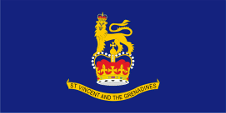
since 1979,
Flag of the Governor General,
ratio = 1:2,
Source, by: Flags of the World




Saint Vincent
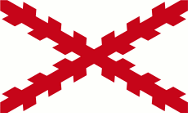
16th century,
The island belongs to the Spanish sphere of influence,
Source, by: Wikipedia (EN)



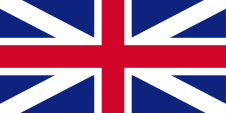
1776–1779, 1783–1801,
Flag of United Kingdom,
Source, by:
Die Welt der Flaggen






1779–1783,
Flag of France,
Source, by: Sodacan [CC BY-SA 3.0], via Wikimedia Commons



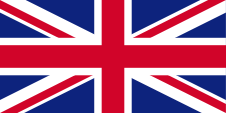
1801–1979,
Union Flag → quasi national flag,
Flag of United Kingdom,
ratio = 1:2,
Source, by: Wikipedia (EN)





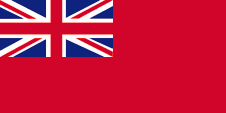
1864–1979,
Merchant flag,
ratio = 1:2,
Source, by: Flags of all Nations





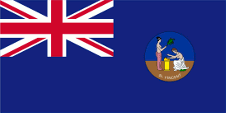
1877–1907,
Flag of the government (state flag),
ratio = 1:2,
Source, by: Flags of the World



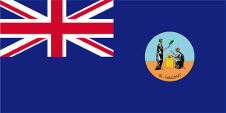
1907–1975,
Flag of the government (state flag),
ratio = 1:2,
Source, by: Flags of the World




1975–1979,
National and state flag,
ratio = 1:2,
Source, by: Flags of the World



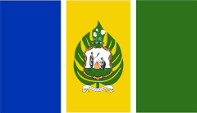
1979–1985,
National, state and merchant flag,
ratio = 4:7,
Source, by: Flags of the World



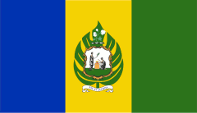
1985 (Mar–Oct),
National, state and merchant flag,
ratio = 4:7,
Source, by: Flags of the World




Windward Islands (1838–1958):
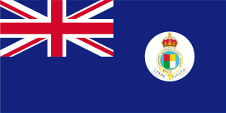
1903–1958, doubtful,
Flag of the government (state flag),
ratio = 1:2,
Source, by: Flags of the World



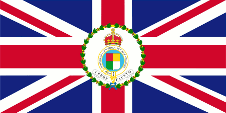
1885–1960,
Flag of the Governor-in-Chief,
ratio = 1:2,
Source, by: Flags of the World



Federation of the West Indies (1958–1962):
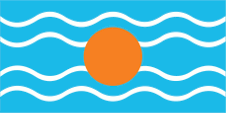
Flag of the Federation of the West Indies,
ratio = 1:2,
Source, by: Flags of the World



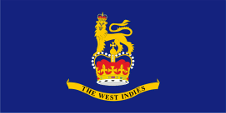
Flag of the Governor General,
ratio = 1:2,
Source, by:
Flags of the World




The current flag of St Vincent was introduced on 21st of October in 1985. It
shows three vertical stripes in blue, yellow and green, in a ratio of 1:2:1.
Three stylised green diamonds form a "V" in the wide yellow central stripe. The
colour blue represents the ocean, yellow the natural wealth and green the
vegetation of the island and its fertility. According to another interpretation,
blue stands for the sky, yellow for the sun and green for the lush vegetation on
the island. The three green diamonds in V-formation stand for "Vincent" and
embody the islands' nickname: "Gems of the Antilles", although they are also
reminiscent of the leaf of the breadfruit tree on the previous flag. As the
country follows the British ensign and colour system, the colours of the flag
will correspond to the spectrum specified by the British Ministry of Defence in
its publication "Flags of all Nations" (a service regulation) for the following
colours: Green = pt 364 c, Red = pt 186 c, Yellow = pt 116 c, Blue = pt 286 c.
St Vincent uses the British Ensign system until today. This points to the links
with United Kingdom, as the naval flag is a white ensign, a white flag with a
continuous red St George's cross and with the national flag in the top corner.
Initially, the island was disputed between France and England/United
Kingdom. In 1762, United Kingdom was able to secure ownership of the island,
which became a crown colony in 1776, so that from that year onwards the flag of
the United Kingdom flew unchallenged over the islands. From that point in time
on, individuals, citizens and also the authorities represented their status as
citizens or organs of the British nation, embodied in the United Kingdom,
through the use of the Union Jack, then called the "Union Flag". At sea, the
British merchant flag, the Red Ensign, was intended for British citizens from
1864. In a few cases, the citizens of a colony were authorised by the Admiralty
to use their own Red Ensign with the colony's badge at sea. The Union Jack in
the top corner of these flags signalled the connection to United Kingdom.
Originally, St Vincent was part of the British colony of the Windward
Islands, later of the Federation of the West Indies. The country became a
dissociated own colony in 1962.
United Kingdom introduced a flag system
in 1864 in which:
• war ships fly the "White Ensign" (naval flag), a white
flag often with an uninterrupted red St. George's-Cross and with the Union Jack
in the upper staff quadrant of the flag,
• merchant ships fly a "Red Ensign"
(also named "Civil Ensign" → civil flag, the real merchant flag), a red flag
with the Union Jack in the upper staff quadrant of the flag, and
•
governmental ships fly the "Blue Ensign" (flag for the use by the gouvernment →
the actual state flag), a blue flag with the Union Jack in the upper staff
quadrant of the flag.
From 1865, the ships of the colonial governments
were allowed to use a Blue Ensign with a badge at the flying end. The respective
governments were to provide appropriate badges. Merchant ships and seafaring
privateers from colonies were only allowed to use a Red Ensign with a badge if
the British Admiralty had issued a corresponding licence for that colony.
Such a badge was often a regional landscape depiction on a disc, often
showed ships, historical events or could simply be a kind of logo. Very often a
badge also contained the name of the country or a motto. However, some
possessions had a coat of arms from the beginning or were given their own coat
of arms over the years and the badge was abolished. To ensure a largely uniform
appearance in the flying end of the flags, coats of arms and other symbols were
displayed on a white disc in the size of the former badges.
However,
there were also exceptions, as some colonies dispensed with this white disc and
placed their coat of arms or even just the shield – sometimes enlarged –
directly on the bunting. As early as the 1940s, the white disc was removed and
the coat of arms was applied directly or enlarged. This conversion process took
place gradually, nowhere simultaneously and completely. In some British
possessions flags with the white disc are still in use today, in others no
longer and in some areas both variants exist side by side.
From 1838 to
1958, the area was part of the British colony of the Windward Islands, a federal
colony consisting of individual sub-areas, sub-colonies or islands. These
individual colonies had their own flags, also called "Blue Ensigns" with their
own badge, for use by the governments of these colonies. The overarching
political entity of the British Windward Islands most likely did not have an
additional Blue Ensign of its own, but its own badge. This badge was created in
1886 and showed an heraldic shield divided into four parts with the colours red,
yellow, green and white, surrounded by a white belt with the inscription
"Governor in Chief, Windward Islands", with the British crown above. Below is a
white banner with the motto of the islands: "i pede fausto" → "Walk with a
blessed foot". In 1903, the design of the crown was changed slightly (to the
Tudor crown). The Governor of Barbados was always also the Governor-in-Chief of
the colony of the British Windward Islands. The Governor-in-Chief used the
Windward Islands badge on his flag after all. He was represented locally by a
governor in the associated sub-territory, sub-colony or island. The federal
colony ceased to exist when it was incorporated into the Federation of the West
Indies, led by a Governor-General. Locally, in the associated sub-territory,
sub-colony or island, the highest representative of the Crown retained his rank.
He remained an administrator or governor. The local flags (e.g. blue or red
ensigns, i.e. separate state or merchant flags) have been retained.
From
1958 to 1962 the territory was also part of the British colony "Federation of
the West Indies". This political project was an attempt to unify the
administration and to create a state modelled on Canada, but also to counteract
the independence efforts of the associated islands and colonies. However,
jealousies arose between the large and small islands and even led to open
dispute. The flag of the "Federation of the West Indies" was a light blue flag
with four horizontal white wavy lines and a golden disc in the middle. It
symbolized the sun over the Caribbean Sea. There is some doubt about the color
of the blue; it is often assumed to be the usual British heraldry blue. However,
a contemporary description calls it an "imperial blue" which would be light blue
and many contemporary prints also show this light blue.
St. Vincent
probably received its own badge in 1877. It showed two classically dressed
allegorical female figures (Peace and Justice) sacrificing at an altar. Until
1907, the name of the country could be found at the bottom of the badge: "St
Vincent"; from 1907, the motto of the colony was written there: "Pax et
Justitia" → "Peace and Justice". An own "Blue Ensign" was probably also
introduced in 1875 as the state flag at sea, a dark blue bunting with a flag
depiction – the British Union Jack – in the upper corner, which showed the badge
in the flying end of the flag.
On 27th of October in 1969, internal
self-government was granted by United Kingdom and St Vincent became an
autonomous state associated with United Kingdom. In this context, a new flag was
to be introduced, which would have ended the tradition of the "Blue Ensigns".
This was not done, although the design for this flag had already been finalised.
In 1975, however, the country was granted the right to use the Blue Ensign with
the badge for decorative purposes as the national flag on land, but probably
only if the governor authorised this and only for a limited period of time, e.g.
at an event (including outside the country) or to distinguish it if the use of
the Union Flag would have been inappropriate or likely to cause confusion. On land, however, the aspect ratio of the flag should be 3:5. From
1979, the "Blue Ensign" was no longer used, as St Vincent became independent.
On 27th of October in 1979, St Vincent was
granted independence by United Kingdom. In this context, the predecessor of
today's flag was introduced. This was designed by a local artist and showed the
same colours as today's flag, also in a vertical arrangement, but the stripes
were the same width. The English College of Arms added narrow white dividing
stripes. In the centre of the yellow stripe was the island's coat of arms on a
large breadfruit leaf to commemorate Captain William Bligh, who brought some
breadfruit trees from Tahiti to the islands as food for the slaves. As this flag
– very beautiful by Caribbean standards – did not meet with the approval of the
population, the white dividing stripes were removed in March 1985. In a further
step, the flag was changed to the current version by a Swiss heraldist on 21st
of October in 1985, despite legal concerns.
Source:
Die Welt der Flaggen,
Flaggen Wappen Hymnen,
Die Welt der Flaggen,
Wikipedia (EN),
Volker Preuß


since 1912,
Coat of arms of Saint Vincent,
Source, by: Corel Draw 4
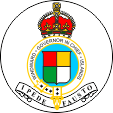
1886–1958,
Windward Islands,
Badge of the Windward Islands,
Source, by: Flags of the World
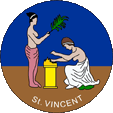
1877–1907,
Saint Vincent,
Badge of Saint Vincent,
Source, by: Flags of the World
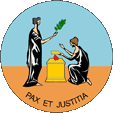
1907–1979,
Saint Vincent,
Badge of Saint Vincent,
Source, by: Flags of the World

The coat of arms was awarded on 29th of November in 1912 and maintained unchanged. It shows a shield with two classical dressed allegorical wife figures (Peace and Justice), who sacrify on an altar. Above the shield appears a blooming cotton plant, below the shield the motto of the country: "Pax et Justitia" → "Peace and Justice".
Source:
Flaggen Wappen Hymnen

Location:

Source: CIA World Factbook
Map of the country:
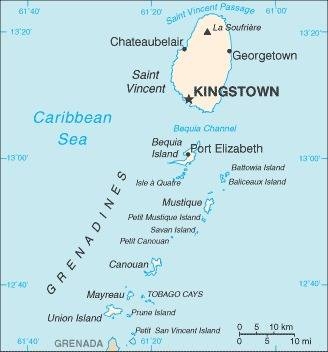
Source: CIA World Factbook

Area: 150 square miles
Inhabitants: 111.000 (2020), thereof 65% Blacks, 19% Mulattos, 5% Indians, 3% Europeans
Religions: 40% Anglican, 30% Protestant, 11% Roman Catholic
Density of Population: 739 inh./sq.mi.
Capital: Kingstown, 12.909 inh. (2012)
official Language: English
other Languages: Creole English
Currency: Eastern Caribbean Dollar (XCD, EC-$) = 100 Cents
Time Zone: GMT – 4 h
Source:
Wikipedia (D)

1498 · the Spanish seafarer Christoph Columbus discovers the island on the day of the Holy Vincent and names it "Isla de San Vincente", the island becomes a Spanish possession but was not colonized
1627 · England claimes the by Caribs inhabited island, but there follows none settlement or colonization
1672 · England claimes the by Caribs inhabited island again, but there follows once more none settlement or colonization
1673 · France claimes the by Caribs inhabited island, but there follows none settlement or colonization, the island was declared for a neutral zone
1719 · French settlers acquire land on the islands
1748 · Saint Vincent is ceded to the Caribs
1762 · United Kingdom occupys Saint Vincent and the Grenadines
1762 · Saint Vincent becomes a British colony
1776 · Saint Vincent becomes a British crown colony
1779–1783 · Saint Vincent is occupied by French troops
1793 · Captain William Bligh, who brings some Bread Fruit Trees from Tahiti to the island as food for the slaves
1795 · revolt of the Caribs
1838 · abolition of slavery
1838–1958 · part of the British Colony of the Windward Islands
1958–1962 · part of the British Colony of the "Federation of the West Indies"
27th of October 1969 · United Kingdom grants interior self administration (autonomy as with United Kingdom associated state)
27th of October 1979 · United Kingdom grants independence within the framework of the Commonwealth of Nations
Source:
Atlas zur Geschichte,
World Statesmen,
Wikipedia (EN)

The name "Saint Vincent" was awarded to this island by Columbus as he discovered it on the day of the Holy Vincent in the year 1498. Saint Vincent of Zaragoza lived in Zaragoza in the 3rd century and was the deacon of the church there. He died a martyr's death around the year 304 under Emperor Diocletian. Saint Vincent Island was named "Youloumain" by the mix of the former slaves with the vanished natives, in honor of Youlouca, the spirit of rainbows.
Source: Wikipedia (EN)


![]()





































![]()
